

The Chemistry of Dienes and Polyenes. Volume 1
Edited by Zvi Rappoport
Copyright ∂ 1997 John Wiley & Sons, Ltd.
ISBN: 0-471-96512-X
CHAPTER 19
Allenyl and polyenyl cations
L. R. SUBRAMANIAN
Institut fur¨ Organische Chemie, Eberhard-Karls-Universitat¨ Tubingen,¨ Auf der Morgenstelle 18, D-72076 Tubingen,¨ Germany
I. INTRODUCTION . . . . . . . . . . . . . . . . . . . . . . . . . . . . . . . . . . . . . . |
869 |
II. ALLENYL CATIONS . . . . . . . . . . . . . . . . . . . . . . . . . . . . . . . . . . . |
870 |
A. Generation by Photolysis . . . . . . . . . . . . . . . . . . . . . . . . . . . . . . . |
870 |
B. Generation by Solvolysis . . . . . . . . . . . . . . . . . . . . . . . . . . . . . . . |
871 |
C. Spectroscopic Identification of Allenyl Cations . . . . . . . . . . . . . . . . . |
881 |
III. BUTATRIENYL CATIONS . . . . . . . . . . . . . . . . . . . . . . . . . . . . . . . . |
883 |
IV. REFERENCES . . . . . . . . . . . . . . . . . . . . . . . . . . . . . . . . . . . . . . . . |
886 |
I. INTRODUCTION
Allenyl cations 1 are a stabilized form of vinyl cations1 3 in which the ˇ-carbon atom of the vinylic structure is part of the substituent which effects the stabilization of the ion via its electron-donating ability. This leads to a resonance hybrid having formally the alkynyl cation structure 2. Allenyl cations should be distinguished from the allenyl substituted carbenium ions 3 formulated as the mesomeric structures of the vinyl cations 4 (dienyl cations) stabilized by an ˛-vinyl group (equation 1).
R1 |
|
+ |
R3 |
|
|
|
|
R1 + |
|
|
R3 |
C |
C |
C |
|
|
|
|
C |
C |
C |
||
|
|
|
|
||||||||
R2 |
|
|
|
|
|
|
|
R2 |
|
|
|
|
(1) |
|
|
|
|
|
|
|
(2) |
|
|
R1 |
|
R3 |
|
|
|
|
|
R1 |
|
R3 |
(1) |
|
|
|
|
|
|
|
+ |
|
|
||
C |
C |
C |
+ |
R4 |
|
|
C |
C |
C |
R4 |
|
R2 |
|
|
|
|
R2 |
|
|
||||
|
|
|
|
|
|
|
|
C |
|||
|
|
|
C |
|
|
|
|
|
|
|
|
|
|
|
R5 |
|
|
|
|
|
|
|
R5 |
|
(3) |
|
|
|
|
|
|
|
(4) |
|
|
869
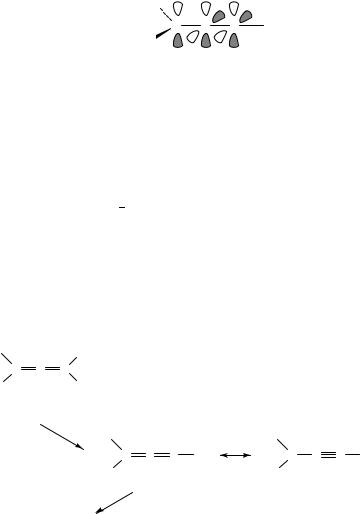
870 |
L. R. Subramanian |
Similar to the allyl cation4 the stabilization in the allenyl cation 1 occurs by overlap of the incipient vacant p orbital with the allenyl -system as shown in 5. The allylic-orbitals are geometrically constrained to the most favored geometry for overlap with the p orbital due to the orthogonality of the two double bonds and the conjugation is not accompanied by any loss of ground state conjugation.
+
C C C
(5)
Allenyl cations have been generated by solvolysis of allenic derivatives, by photolysis of allenyl halides and by reaction of metal salts with allenyl and propargyl halides. This review will delineate these reactions. The related butatrienyl cations are not many and they will be only briefly described.
II.ALLENYL CATIONS
A.Generation by Photolysis
Photolysis of the carbon halogen bond to give carbenium ions5,6 has been extended to the formation of vinyl cations by Taniguchi, Kobayashi and coworkers7. In this context several chlorotriarylallenes 6 were photolyzed in a mixed solvent system of methanol and dichloromethane8. The photolysis was carried out at 30 °C to prevent a thermal solvolysis of the substrate. The major product of the reaction is the 1,3,3-triaryl-3- methoxypropyne 8 with a small amount of the reduced compounds 9 and/or 90 as the side product. Photolysis of 6 (Ar1 D Ar2 D Ph) in ethanol and 2-propanol gave the corresponding 3-alkoxy-1,3,3-triphenylpropynes (8a-OEt and 8a-OPr-i) in 33 and 37% yields, respectively, together with a small amount of the reduced product 90 (Ar2 D Ar1 D Ph)8.
Ar2 |
|
|
|
|
|
|
|
Ar1 |
|
(a) Ar1 = Ar2 = Ph |
|
|
|
|
|
|
|
|||||
C |
|
C |
|
C |
|
(b) Ar1 = Ph, Ar2 = 4-MeC6 H4 |
|
|
|
|
|
|
||||||||||
Ar2 |
|
|
|
|
|
|
|
Cl |
|
(c) Ar1 = 4-MeOC6 H4 , Ar2 = Ph |
|
|
|
|
|
|
||||||
|
(6) |
|
|
|
|
|
|
|
|
|
|
|
|
|
|
|
|
|
|
|
||
|
|
|
|
|
|
|
hν |
|
|
|
|
|
|
|
|
|
|
|
|
|
||
|
|
|
|
|
|
Ar2 |
Ar2 |
|
|
|
|
|
|
|||||||||
MeOH-CH2 Cl2 |
|
|
|
|
|
|
||||||||||||||||
−30 °C |
|
|
|
|
+ |
|
|
+ |
|
|
|
|
|
|
||||||||
|
|
|
|
|
|
C C C Ar1 |
C C C Ar1 |
|
||||||||||||||
|
|
|
|
|
|
|
|
|
|
Ar2 |
Ar2 |
|
|
|
|
(2) |
||||||
|
|
Ar2 |
|
|
|
|
|
(7) |
|
|
|
|
|
|
|
|
|
|
||||
|
|
|
|
|
|
|
|
|
|
|
|
|
|
|||||||||
|
|
|
|
|
|
|
|
|
|
|
|
|
|
|
|
|
|
|
||||
Ar2 |
|
|
|
|
|
|
|
|
|
|
|
Ar1 + (Ar2 )2 C |
|
|
|
CHAr1 and / or (Ar2 )2 CHC |
|
|
|
Ar1 |
||
|
C |
|
|
C |
|
C |
|
|
|
C |
|
|
C |
|
||||||||
|
|
|
|
|
|
|
|
|||||||||||||||
|
|
|
|
|
|
|
|
|
||||||||||||||
|
|
|
|
|
|
|
|
|||||||||||||||
|
|
|
|
|
|
|
|
|
||||||||||||||
|
|
|
|
|
|
|
|
|||||||||||||||
|
|
|
|
OMe |
|
|
|
|
|
|
|
(9′ ) |
||||||||||
|
|
|
|
|
|
|
|
|
||||||||||||||
|
|
|
|
|
|
(8) |
|
(9) |
|
|||||||||||||
|
|
|
|
|
|
(a) 47% |
|
|
|
|
|
|
|
(a) 7% |
||||||||
|
|
|
|
|
|
(b) 51% |
|
|
|
|
|
|
|
(b) trace |
||||||||
|
|
|
|
|
|
(c) 76% |
|
|
|
|
|
|
|
(c) trace |
||||||||

19. Allenyl and polyenyl cations |
871 |
The formation of solvent-incorporated products 8 suggested that triarylallenyl cations 7 are formed by photolysis of the corresponding chloroallenes 6 (equation 2). However, the products 8 obtained by photolysis were attributed to attack by nucleophiles at -positions of the allenyl cation. Although allenyl cations are ambident cations and can produce allenyl or propargyl derivatives by attack at the ˛- or -position, respectively, only -attack was observed in this photolysis of triarylchloroallenes. This result is parallel to that observed by Schiavelli and coworkers9 in the solvolysis of these systems (vide infra) which therefore supports the formation of allenyl cations in the photolysis.
B. Generation by Solvolysis
The intermediacy of allenyl cations in the solvolysis of allenic derivatives was first shown by Jacobs and Fenton10. However, the main work on the mechanism of the reaction is that of Schiavelli and coworkers11 17, who showed with the aid of kinetics and substituent, solvent, salt and isotope effects that the reactions proceed via an initial cleavage of the bond to the leaving group with the formation of the allenyl cations 1. Chlorotriarylallenes have been shown to solvolyze with convenient rates and even a primary allenyl cation was generated solvolytically. Extensive coverage of earlier work on the solvolytic behavior of allenyl systems are given elsewhere1b d. One of the most interesting features is the ambident character of allenyl cations, which can provide, on reaction with a nucleophile, the allenyl and/or propargyl derivatives. However, most work on solvolysis of allenyl halides indicates that nucleophiles attack at the
-position of the resulting allenyl cations, unless bulky substituents are present on the
-position12.
Recently, the solvolyses of 1-chloro-1,3,3-triarylallenes 10 (and of 1-butyl-3,3-diphenyl- allenyl chloride) were carried out in the presence of thiocyanate and o-ethyl dithiocarbonate anions as nucleophiles and found to give the corresponding allenyl derivatives 11 and 12 in good yield (equation 3)18. However, when potassium cyanate was used as a nucleophile, the cyanate ion attacked at the -position to give the propargyl amines 14 after decarboxylation of the unstable intermediate 13 (equation 4).
|
|
Ar2 |
Ar1 |
|
||
|
|
C C |
C |
|
||
|
|
Ar2 |
Cl |
|
||
|
|
(10) |
|
|
|
|
|
|
|
|
|
|
|
|
|
aq. acetone |
|
aq. acetone |
|
|
|
|
KSCN, 25 °C |
|
KS2 COEt, 25 °C |
|
(3) |
|
|
|
|
|
|
|
|
|
|
|
|
|
|
Ar2 |
Ar1 |
Ar2 |
Ar1 |
|||
C C |
C |
C C |
C |
|||
Ar2 |
SCN |
Ar2 |
S COEt |
|||
|
|
|
|
|
|
S |
(11) |
(a) Ar1 = Ar2 = Ph, 98% |
(12) |
(a) 73% |
|||
|
|
(b) Ar1 = Ph, Ar2 = 4-MeC6 H4 , 88% |
(b) 57% |
|||
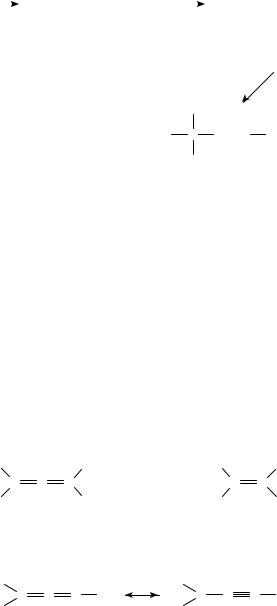
872 |
|
|
|
|
|
|
|
|
L. R. Subramanian |
|
|
|
|
|
|
|
|
|
|
|
|||||
|
|
|
|
|
Ar2 |
|
|
|
|
|
|
|
|
Ar2 |
|||||||||||
10 |
aq. acetone |
|
|
|
|
|
|
|
|
H2 O |
|
|
|
|
|
|
|
|
|
|
|
||||
|
|
|
|
|
|
|
|
|
|
|
|
|
|
|
|
|
|||||||||
|
|
Ar2 |
|
C |
|
C |
|
C |
|
Ar1 |
|
Ar2 |
|
C |
|
C |
|
C |
|
Ar1 |
|||||
|
|
|
|
|
|
|
|
|
|
|
|||||||||||||||
|
KNCO, 25 |
°C |
|
NCO |
|
|
|
|
|
|
|
|
|
|
NHCO2 H |
||||||||||
|
|
|
|
|
|
|
|
|
|
|
|
||||||||||||||
|
|
|
|
|
|
|
|
|
|
|
|
|
|
|
|
|
|||||||||
|
|
|
|
|
|
|
|
|
|
|
|||||||||||||||
|
|
|
|
|
|
|
|
|
|
|
|
|
|
|
(13) |
|
|
|
|||||||
− (4)
CO2
Ar2
Ar2 C C C Ar1
C Ar1
NH2
(14)(a) Ar1 = Ar2 = Ph, 45%
(b)Ar1 = Ph, Ar2 = 4-MeC6 H4 , 68%
These results indicate that the reaction outcome can be controlled by the choice of nucleophile. From the kinetic12 and theoretical19 (vide infra) studies, it is predicted that nucleophiles react at the propargyl position of the allenyl cation. However, when the - position bears a sterically hindered substituent, a nucleophile should attack on the allenyl position13. Such a steric factor may be also operative for a bulky nucleophile. Among the nucleophiles used, thiocyanate and o-ethyl dithiocarbonate anions are larger than cyanate anion because sulfur atom has a much larger van der Waals radius than that of nitrogen or oxygen atom20. The larger nucleophile prefers to attack the less sterically congested allenyl position, while the smaller nucleophile prefers the propargyl position, which is more reactive than the allenyl position12,19.
The kinetic studies on the solvolysis of 1-aryl-1-chloro-3-methylbuta-1,2-dienes (15, Ar D Ph, p-MeOC6H4) showed that the values ( C D 2.8 in 80% aqueous ethanol and2.9 in aqueous acetone)21 are much lower than those of the correspondingly substituted vinyl derivative 16 ( C D 4.3 in aqueous ethanol)22. This result indicates that the ˛- substituent effect in cations 17a is much smaller than in the vinyl cations, suggesting
R |
|
|
Ar |
R |
Ar |
C |
C |
C |
C |
C |
|
R |
|
|
Cl |
R |
OTs |
(15) |
(a) |
Ar = Ph |
|
(16) |
|
|
|
(b) Ar = p−MeOC6 H4 |
|
|
|
R |
C |
+ |
R + |
C Ar |
|
C |
C Ar |
C C |
|||
R |
|
|
|
R |
|
|
(17) |
|
(18) |
|
|
|
(a) |
R = Me |
(a) |
R = Me |
|
|
(b) |
R = Ph |
(b) |
R = Ph |
|
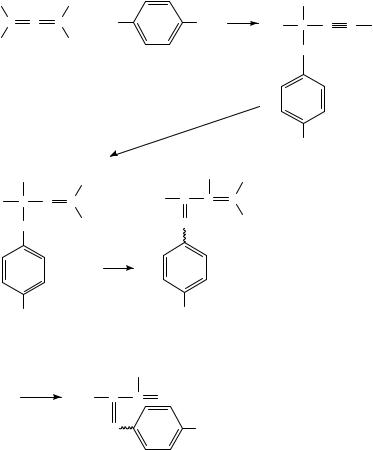
19. Allenyl and polyenyl cations |
873 |
that the contribution of the propargyl structure 18a in the transition state is important. Furthermore, from these values and comparison of the m values (0.88 in aqueous EtOH) for the chloroallene 15a and the values of the 1-chloro-1,3,3-triarylallenes 10 ( C D2.0 in aqueous acetone)10, it was concluded that in the 1-aryl-3,3-dimethyl-substituted allenyl derivative 15 (R D Me) the contribution of the propargyl structure 18a is greater in the transition state in comparison with the allenyl structure 17a.
Reaction of 1-chloro-1,3,3-triphenylallene (19) with p-toluidine in the presence of silver triflate gave 2,3,4-triphenylbuta-1-aza-1,3-diene derivative 22a via a novel 1,2-phenyl shift not reported earlier in the solvolysis of allenyl chlorides23. The reaction takes place via the formation of the allenyl cation, which is captured as its canonical propargyl cation, first affording the protonated amine 20 (R D Me). Proton transfer24 from the nitrogen to the acetylenic carbon is followed by migration of a phenyl group in the intermediate vinyl cation 21 (R D Me) to afford the iminium triflate 22a. The latter is hydrolyzed by aqueous sodium hydroxide to the azabutadiene 23 (equation 5). Similar reaction of 19 with aniline and silver triflate afforded the corresponding iminium triflate 22b23.
Ph |
Ph |
C C C |
+ R |
Ph |
Cl |
(19) |
|
Ph H
+
Ph C C C
NH OTf− Ph
O
R
(21)
OH −
Ph C
R = Me
|
Ph |
|
|
NH2 |
A gOTf |
|
|
Ph C |
C |
C Ph |
|
|
MeCN |
|
|
R = Me, H |
NH2 |
+ |
OTf− |
|
|
|
|
|
R |
|
|
(20) |
|
Ph |
H |
|
|
|
Ph C |
C C |
|
+ NH |
|
Ph |
|
OTf− |
(5) |
|
|
R
(22)(a) R = Me, 88%
(b)R = H, 68%
Ph
C CHPh
N |
Me |
(23)
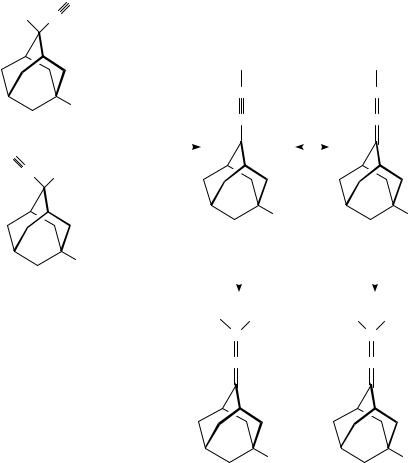
874 |
L. R. Subramanian |
Solvolysis of the propargyl chlorides E- and Z-24 (stereochemistry based on Cl and Ph25) in 80% aqueous ethanol at 50 °C gave, besides the corresponding solvent captured substituted propargyl products, the allenyl chlorides E- and Z-25 formed with complete retention via the allenyl cation intermediate (equation 6)25.
CH
Cl C
|
|
|
|
H |
|
|
|
H |
||
|
|
|
|
C |
|
|
|
C + |
||
Ph |
|
C |
|
|
|
C |
||||
(E-24) |
|
|
|
|
|
|||||
80% EtOH |
+ |
|
|
|
|
|
||||
HC |
|
|
|
|
|
|||||
|
|
|
|
|
|
|
|
|
||
C Cl |
|
|
|
|
|
|
|
|
||
|
|
|
|
|
Ph |
|
|
|
|
Ph |
|
|
|
|
|
|
|
|
|
(6) |
|
Ph |
|
|
|
|
|
|||||
|
|
|
|
|
|
|
||||
|
for E-24 |
|
|
|
|
for Z-24 |
||||
(Z-24) |
|
|
|
|
|
|||||
|
|
|
|
|
|
|
||||
|
|
|
Cl |
|
H |
|
|
H |
|
Cl |
|
|
|
|
C |
|
|
|
C |
||
|
|
|
|
C |
|
|
|
C |
||
Ph |
Ph |
(E-25) |
(Z-25) |
Intermediate allenyl cation 26 has been implied in the reaction of oct-3-yn-2-one (27) with trifluoromethanesulfonic anhydride, which forms vinyl triflates (equation 7)26.
Ferrocenyl-substituted allenyl cations 28 were generated when 1,3-diferrocenyl- substituted secondary and ferrocenyl-substituted tertiary alcohols 29 were treated with trifluoroacetic acid27. These were rapidly converted into trifluoroacetoxyallylic ions by solvent addition; the ions gave ferrocenyl-substituted enones by reaction with water (equation 8).
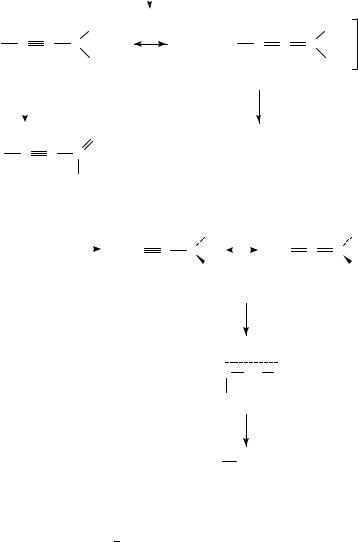
19. Allenyl and polyenyl cations |
875 |
|||||||||||
C3 H7CH2 |
|
C |
|
|
C |
|
C |
|
CH3 |
|
||
|
|
|
|
|
|
|||||||
|
|
|
|
|
|
|||||||
|
|
|
|
|
|
|||||||
|
|
|
|
|
|
|
|
|
|
|
|
|
|
|
|
|
|
|
|
O |
|
||||
(27) |
|
|
|
|
|
|
|
|||||
|
|
|
||||||||||
|
Tf O |
− O Tf− |
|
|||||||||
2 |
|
|
|
|
|
|
|
|
|
|
||
|
|
|
|
|
|
|
|
|
|
|
|
|
|
|
|
|
|
|
|
+ CH3 |
|||
|
C3 H7CH2 |
C |
C |
C |
||||||
|
|
|
|
|
|
|
OTf |
|||
|
|
|
|
|
|
|
CH2 |
|||
|
|
|
|
|
|
|
||||
|
|
|
|
|
|
|
||||
|
C3 H7CH2 |
C |
C |
C |
||||||
|
|
|
|
|
|
|
OTf |
|||
|
|
|
|
|
|
|
|
|
||
FcC |
|
C-C(OH)R1R2 |
H+ |
|
FcC |
|||||
|
|
|
|
|||||||
|
H2 O |
|
||||||||
|
|
|||||||||
|
|
|
|
|
|
|
|
|||
|
|
|
|
(29) |
|
|
|
|
|
|
|
|
|
|
|
|
|
|
|
||
Fc = 1,2-di-t-butylferrocenyl, R1 = R2 = Me Fc = ferrocenyl, R1 = R2 = Me
Fc = ferrocenyl, R1 = R2 = Ph Fc = R1 = ferrocenyl, R2 = Me
+CH3
C3 H7CH2 C C C
OTf
(26)
C3 H7CH |
|
C |
|
C |
|
|
C |
|
CH3 |
||||
|
|
|
|
|
|||||||||
|
|
|
|
||||||||||
|
|
|
|
|
|||||||||
|
|
|
|
OTf |
|
|
|
|
(7) |
||||
|
|
|
|
|
|
||||||||
|
|
|
|
|
|
|
|
|
|
|
|||
|
|
|
|
|
|
|
|
||||||
+ |
R1 |
+ |
R1 |
|
|||||||||
C C |
|
|
|
|
|
|
|
FcC |
C C |
|
|||
|
|
|
|
|
|
|
|
||||||
|
R2 |
|
|
|
|
R2 |
|
||||||
|
(28) |
|
|
|
|
|
|
|
|||||
|
|
|
|
|
|
|
|
||||||
CF3 CO2 H
(8)
+
FcC CH CR1 R2
OCOCF3
H2 O
FcCO CH  CR1R2
CR1R2
The |
|
products from the acid-catalyzed hydration of ˛-tertiary alcohols 30 |
(Meyer |
|
Schuster and Rupe rearrangements) are formed via the mesomeric propargyl- |
|
allenyl cation (equation 9) and have been extensively investigated28.
When 2-ethynyl-2-hydroxyadamantane (31) was treated with 95% formic acid or dilute sulfuric acid only a Meyer Schuster rearrangement took place to give 95% of 2-(formylmethylene)adamantane (32) (equation 10). No Rupe rearrangement took place29.
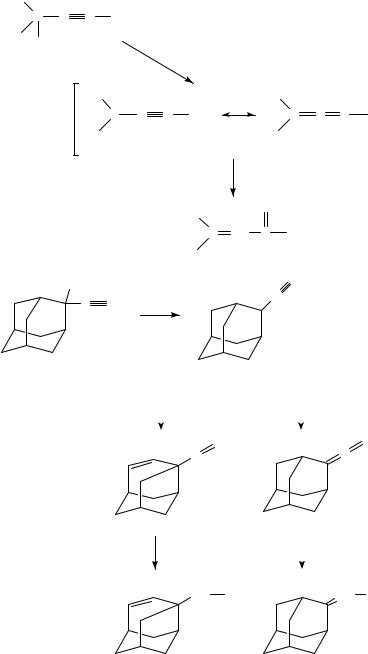
876 |
L. R. Subramanian |
CH3
C C C CH3
CH3 OH
(30)H+
−H2 O |
|
|
|
|
CH3 |
CH3 |
|
||
C+ C C CH3 |
C C C+ CH3 |
(9) |
||
CH3 |
CH3 |
|||
|
||||
|
|
|
|
|
H2 O
O
CH3
C CH C CH3
CH3
CH
OH
C
C CH H + +
− H2 O
(31)
Rupe rearrangement |
|
|
|
Meyer-Schuster rearrangement |
|
|
|
|
|||
|
|
|
|
+ |
|
|
|
|
|
||
+ |
CH2 |
CH |
|||
C |
|||||
|
C |
|
|
||
(10)
H2 O |
H2 O |
|
|
CO CH3 CH CHO
(32)
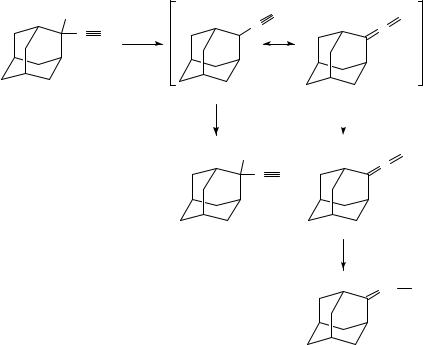
19. Allenyl and polyenyl cations |
877 |
2-Chloro-2-ethynyladamantane (33) was the major product when 31 was reacted with concentrated hydrochloric acid. If 1,4-dioxane was used as the solvent, 82% of 2- (formylmethylene)adamantane (32) was obtained together with only 3% of the chloro product 33 (equation 11). It is remarkable that no reaction takes place even under reflux conditions with ethereal hydrogen chloride29.
OH |
|
CH |
+ |
|
CH |
||
C CH |
H + |
+ C |
C |
|
|
||
|
− H2 O |
|
|
(31)
+ Cl − |
+ H2 O |
|
|
Cl |
CHOH |
|
C |
||
|
||
|
C CH |
(33)
CH CHO
(32) (11)
Similar to the cycloaddition of allyl cations30, allenyl cations have been found to undergo cycloadditions with alkenes to afford bicyclic compounds31. The allenyl cations were generated from propargyl chlorides by treatment with Lewis acids. This reaction sequence proceeds via the cyclization 34 ! 3532, in spite of the fact that 1-cyclopentenyl cations are highly unstable and are not formed during solvolysis of cyclopent-1-enyl triflates33. The reaction takes place by a stepwise cycloaddition of the intermediate allenyl cation 36 to an olefinic CDC bond proceeding via cation 34 to afford vinyl cation 37 (equation 12)34.
The cycloaddition of allenyl cations with monoolefins lead to [2 C 2]- or [3 C 2]-cycloadducts based on the substituents in the allenyl cations as exemplified in equation 1332.
The cycloaddition of allenyl cations with 1,3-dienes results in a number of intermediate cations from which different products result. The allenyl cations 38 are generated first by the reaction of propargyl chlorides with zinc chloride and are then allowed to react with cyclopentadiene or other 1,3-dienes. The products of cycloaddition depend on the substituents on the allenyl cations32,35. The products formed with cyclopentadiene are given in equation 14.

878 |
|
|
|
|
|
|
|
|
|
|
|
|
|
|
L. R. Subramanian |
|
|
|
|
|||||
|
|
|
|
|
|
|
|
|
|
|
|
|
|
|
|
|
R2 |
|
|
|
|
|
|
|
|
|
|
|
|
|
|
|
|
|
R1 |
C |
|
|
C |
C R3 |
|
|
|
|
|||||
|
|
|
|
|
|
|
|
|
|
|
|
|
|
+ C |
C |
|
|
|
|
|
|
|||
|
|
|
|
|
|
R1 = A lkyl |
|
|
|
|
R1 = A ryl |
|
|
|
|
|||||||||
|
|
|
|
|
|
|
|
|
|
|
|
|
|
|
|
|
||||||||
|
|
|
+ |
|
|
|
|
|
|
|
(34) |
|
R1 |
C+ |
R2 |
|
|
|||||||
R |
1 |
|
|
R |
2 |
|
|
|
|
|
|
|
|
|
|
|
(12) |
|||||||
|
|
|
|
|
|
|
|
|
|
|
|
|
|
|
|
|
|
|
R3 |
|
|
|||
|
|
|
|
|
|
|
|
|
|
|
|
|
|
|
|
|
|
|
R2 |
|
|
|
||
|
|
|
|
|
|
|
R3 |
R1 |
+ |
|
|
|
|
|
|
|||||||||
|
|
|
|
|
|
|
|
|
|
|
|
C C |
|
C |
|
|
|
|
|
|
||||
|
|
|
(35) |
|
|
|
|
|
|
|
(36) |
|
R3 |
(37) |
|
|
||||||||
|
|
|
|
|
|
|
|
|
|
|
|
|
|
|
||||||||||
|
|
|
|
|
|
|
|
|
|
|
|
|
+ |
|
|
|
|
|
|
|
|
|||
|
|
|
|
|
|
|
|
|
|
|
|
|
|
|
C |
|
C |
|
|
|
|
|
|
|
|
|
|
|
|
|
|
CH3 |
|
|
|
|
|
|
|
+ |
CH3 |
|
|
|
|||||
|
|
|
|
|
|
|
|
|
|
|
|
|
|
|
ZnCl2 |
|
|
|
|
|
||||
R |
|
C |
|
C |
|
C |
|
|
CH3 |
|
|
|
R |
C C |
C |
|
|
|
||||||
|
|
|
|
|
|
|
|
|
|
|
|
|
||||||||||||
|
|
|
|
|
|
|
|
|
|
|
||||||||||||||
|
|
|
|
|
|
|
|
|
|
|
|
|
||||||||||||
|
|
|
|
|
|
|
|
|
|
|
|
|
|
|
|
|
|
|
|
|
CH3 |
|
|
|
|
|
|
|
|
|
|
Cl |
|
|
|
|
|
|
|
|
|
|
|
|
|
|
|||
|
|
|
|
|
|
|
|
|
|
|
|
|
|
|
|
|
|
|
|
|
|
|||
|
|
|
|
|
|
|
|
|
|
|
|
|
|
|
|
|
|
|
|
|
CH3 |
|
|
|
|
|
|
|
|
|
|
|
|
|
|
|
|
|
|
|
|
|
|
|
CH2 |
C |
|
|
|
|
|
|
|
|
|
|
|
|
|
|
|
|
|
|
|
|
|
|
|
|
CH3 |
|
|
|
|
|
|
|
|
|
|
|
|
|
|
|
R = Ph |
|
|
|
|
|
|
|
R = CH3 |
|
|||
|
|
|
|
|
|
|
|
|
|
|
|
|
|
|
|
|
|
|
|
|||||
|
|
|
|
|
|
|
|
|
|
|
|
|
|
|
|
|
|
|
|
|
|
|
|
|
|
|
|
|
|
|
|
|
|
|
|
|
|
|
|
|
|
|
|
|
|
|
|
|
|
|
|
|
|
|
|
|
|
|
|
Ph |
|
|
|
CH3 |
|
|
|
|
|
H3 C |
+ |
|
||
|
|
|
|
|
|
|
|
|
|
|
|
C+ |
|
|
|
|
|
|
|
|
|
|||
|
|
|
|
|
|
|
|
|
|
|
|
|
|
|
|
|
|
|
H3 C |
|
CH3 |
|||
|
|
|
|
|
|
|
|
|
|
|
|
|
|
|
|
|
CH3 |
|
|
|
|
|||
|
|
|
|
|
|
|
|
|
|
|
|
|
|
|
|
|
|
|
|
|
|
|
||
|
|
|
|
|
|
|
|
|
|
H3 C |
|
|
|
|
|
|
|
|
|
H3 C |
|
CH3 |
||
|
|
|
|
|
|
|
|
|
|
|
|
|
|
|
|
|
|
|
|
|
|
|||
|
|
|
|
|
|
|
|
|
|
|
|
CH3 |
|
|
|
|
|
|
|
|
||||
|
|
|
|
|
|
|
|
|
|
|
|
|
Cl |
|
|
|
|
|
H3 C |
|
Cl |
|||
|
|
|
|
|
|
|
|
|
|
Ph |
C |
|
|
CH3 |
|
|
|
|
||||||
|
|
|
|
|
|
|
|
|
|
|
|
|
|
|
|
|
|
|||||||
|
|
|
|
|
|
|
|
|
|
|
|
|
|
|
|
|
|
|
H3 C |
|
CH3 |
|||
|
|
|
|
|
|
|
|
|
|
|
|
|
|
|
|
|
|
CH3 |
|
|
|
|
||
|
|
|
|
|
|
|
|
|
|
|
H3 C |
|
|
|
|
|
|
|
|
|
H3 C |
|
CH3 |
|
|
|
|
|
|
|
|
|
|
|
|
|
|
CH3 |
|
|
|
|
|
|
|
|
|||
|
|
|
|
|
|
|
|
|
|
|
|
|
53% |
|
|
|
|
|
|
|
38% |
(13) |
||
|
|
|
|
|
|
|
|
|
|
|
|
|
|
|
|
|
|
|
|
|
|
|
|
|
